Qualcomm Snapdragon 805 Performance Preview
by Anand Lal Shimpi on May 21, 2014 8:00 PM EST- Posted in
- Tablets
- Snapdragon
- Qualcomm
- Mobile
- SoCs
- Snapdragon 805
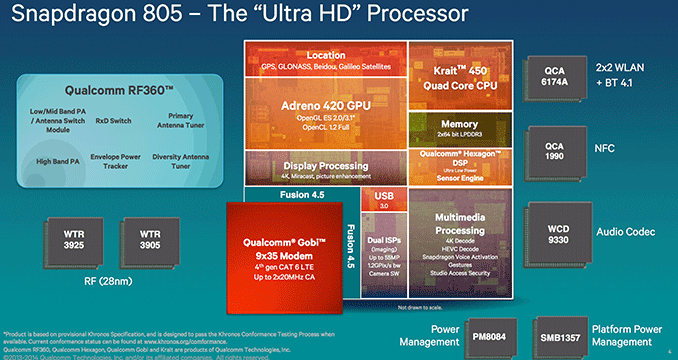
Last year Qualcomm announced a new tier in its high end SoC roadmap with the Snapdragon 805. Priced somewhat above the current Snapdragon 800/801, the 805 would be the last 32-bit high-end SoC from Qualcomm. It would be the grand finale in Krait's lineage, which started back in 2012 with Krait 200 and MSM8960 and saw iterative improvements over the years. The Snapdragon 805 was not only designed to drive CPU performance higher but also be the launch vehicle for Qualcomm's brand new Adreno 4xx GPU architecture.
The Snapdragon 805 SoC is a beast. It features four Krait 450 cores, each a mild tweak of the Krait 400 design used in the S800/801. These cores can now run at up to 2.7GHz compared to 2.5GHz in the Snapdragon 801 (Krait 400). As always, Qualcomm advertises customer-friendly frequencies rounded up to the nearest 100MHz, the actual max frequency of each Krait 450 core is 2.65GHz (compared to 2.45GHz in Krait 400).
The 8% increase in max frequency comes from tuning at the circuit level, there's no impact to IPC. All four cores sit behind a shared 2MB L2 cache. As is the case with all multi-core Krait SoCs, each CPU core can be power gated, clock gated and even clocked independently of the rest.
The S805 features Qualcomm's Adreno 420 GPU with full support for OpenGL ES 3.1 (with some extensions), OpenCL 1.2 and Direct3D feature level 11_2 (with a hardware tessellation engine). In typical Qualcomm fashion, it isn't disclosing any material details on the underlying Adreno 420 architecture so we'll have to guess based on what the benchmarks tell us. Adreno 420 includes support for Adaptive Scalable Texture Compression (ASTC), a new texture compression first introduced by ARM in 2011.
There are other architectural improvements including better texturing performance and faster depth rejection. The architecture should be more efficient than Adreno 3xx as well, making better use of the underlying hardware.
The GPU runs at a max frequency of 600MHz.
Qualcomm claims a 20% reduction in power consumption compared to Adreno 330 (Snapdragon 800) when running the T-Rex HD test from GFXBench at 1080p (onscreen).
For the first time, the GPU now gets its own direct path to the SoC's memory interface. In the past the GPU shared a bus with the ISP and video engines, but in order to feed the beast that had to change. The memory interface on S805 features two 64-bit LPDDR3-800 partitions (4 x 32-bit external interfaces), each capable of supporting 1600MHz datarate LPDDR3 for an aggregate peak theoretical bandwidth figure of 25.6GB/s. The Krait 450 cores themselves aren't big enough to use all of that memory bandwidth. The wide memory interface is really there for the GPU and video engines. We haven't seen a memory interface this wide on a mobile SoC since Apple's A5X/A6X designs.
In order to accommodate the wider memory interface but still make Snapdragon 805 suitable for use in a smartphone as well as a tablet, Qualcomm turned to a different packaging technology. Since the Snapdragon 805 is an APQ part, it lacks the integrated modem of the MSM SoCs we've found in most of Qualcomm's recent flagships. S805 uses a Moulded Embedded Package (MEP) that allows Qualcomm to route its 128-bit wide memory interface to on-package DRAM, giving it all of the benefits of a PoP stack as well as the wider memory interface. Qualcomm wouldn't provide me with a ton of details on MEP other than to say that rather than using the perimeter of the SoC's package to connect to memory stacked above it, MEP uses a substrate layer on top of the SoC to connect to the memory, giving the SoC more surface area to route lines to the DRAM. Qualcomm also claims the amount of metal it uses in the DRAM's substrate layer has some small impact on improving thermals on the overall package. The result is that Snapdragon 805 is still compact enough to go into a smartphone as long as the design can accomodate a discrete modem.
The Snapdragon 805 also marks Qualcomm's first SoC with a hardware H.265/HEVC video decode engine. There's no hardware H.265 encode acceleration however, that won't come until Snapdragon 810 in 2015.
The S805's ISP sees an increase in performance as well. The SoC retains Qualcomm's dual-ISP design, now capable of pushing up to 1.2 Gigapixels/s through the engine. If Qualcomm arrives at that number the same way as it has in the past, that would imply a 600MHz ISP operating frequency (up from 465MHz in the Snapdragon 801). The new ISP supports up to four MIPI camera inputs (TrioCam + FF anyone?). The ISP can support 4k30 and 1080p120 video capture.
Qualcomm also claims improved autofocus performance and better noise reduction.
Just as in years past, Qualcomm invited us out to a benchmarking workshop to get some hands on time with its Snapdragon 805 Mobile Development Platform (MDP) ahead of actual device availability. And just like we saw with the Snapdragon 800 benchmarking workshop, the S805's MDP comes in tablet form.the Snapdragon 805 MDP/T features a 10.6" 2560 x 1440 display, 3GB of LPDDR3 memory and 64GB of internal storage (eMMC 5.0). The chassis looks very similar to previous MDP/T designs.
Just as before, the benchmarks that follow are of a pre-production device that isn't shipping hardware. Although Qualcomm has significantly improved the delta we've seen between MDPs and shipping devices, there's always the caveat that performance could be different once we are looking at a shipping device, running on battery power. Although Qualcomm gave us access to the MDP/T, the devices were running on AC power with no power instrumentation connected. Qualcomm's own data shows a reduction in power consumption for Snapdragon 805 vs. 800, but once again we'll have to wait for shipping devices to really understand the impact of the SoC on battery life. What follows is exactly what the title of this piece indicates: a preview of Snapdragon 805 performance. Although Qualcomm pre-loaded the MDP/T with some commonly used benchmarks, we installed our own copies of everything we ran.
| Qualcomm's Snapdragon 8xx Lineup | |||||||
| Snapdragon 810 | Snapdragon 808 | Snapdragon 805 | Snapdragon 801 | Snapdragon 800 | |||
| Internal Model Number | MSM8994 | MSM8992 | APQ8084 | MSM8974 v3 | MSM8974 v2 | ||
| Manufacturing Process | 20nm | 20nm | 28nm HPm | 28nm HPm | 28nm HPm | ||
| CPU | 4 x ARM Cortex A57 + 4 x ARM Cortex A53 (big.LITTLE) | 2 x ARM Cortex A57 + 4 x ARM Cortex A53 (big.LITTLE) | 4 x Qualcomm Krait 450 | 4 x Qualcomm Krait 400 | 4 x Qualcomm Krait 400 | ||
| ISA | 32/64-bit ARMv8-A | 32/64-bit ARMv8-A | 32-bit ARMv7-A | 32-bit ARMv7-A | 32-bit ARMv7-A | ||
| GPU | Adreno 430 | Adreno 418 | Adreno 420 | Adreno 330 | Adreno 330 | ||
| H.265 Decode | Yes | Yes | Yes | No | No | ||
| H.265 Encode | Yes | No | No | No | No | ||
| Memory Interface | 2 x 32-bit LPDDR4-1600 | 2 x 32-bit LPDDR3-933 | 4 x 32-bit LPDDR3-800 | 2 x 32-bit LPDDR3-800/933 | 2 x 32-bit LPDDR3-800/933 | ||
| Integrated Modem | 9x35 core, LTE Category 6/7, DC-HSPA+, DS-DA | 9x35 core, LTE Category 6/7, DC-HSPA+, DS-DA | - | 9x25 core, LTE Category 4, DC-HSPA+, DS-DA | 9x25 core, LTE Category 4, DC-HSPA+, DS-DA | ||
| Integrated WiFi | - | - | - | - | - | ||
| eMMC Interface | 5.0 | 5.0 | 5.0 | 5.0 | 4.5 | ||
| Camera ISP | 14-bit dual-ISP | 12-bit dual-ISP | 1.2 GP/s | 930 MP/s | 640 MP/s | ||
| Shipping in Devices | 1H 2015 | 1H 2015 | 2H 2014 | Now | Now | ||
I pulled comparison results from our new combined Phone/Tablet 2014 category in Bench. The key comparisons here are the iPad Air (for obvious reasons), ASUS' Transformer Pad TF701T (Tegra 4 in a tablet), ASUS' Transformer Book T100 (Intel's Bay Trail in a tablet) and the HTC One (M8)/Samsung Galaxy S 5 (both are Snapdragon 801 devices). With the exception of the Bay Trail based T100, everything else runs iOS or Android.



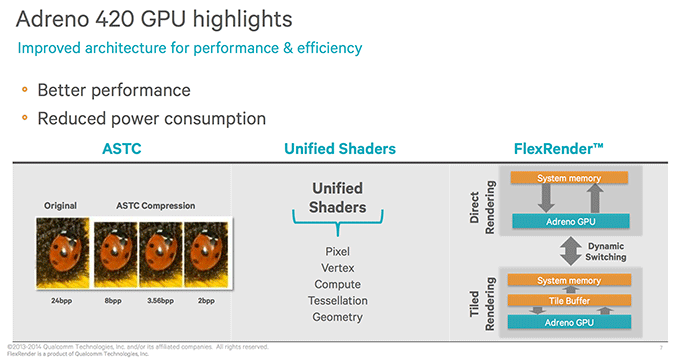
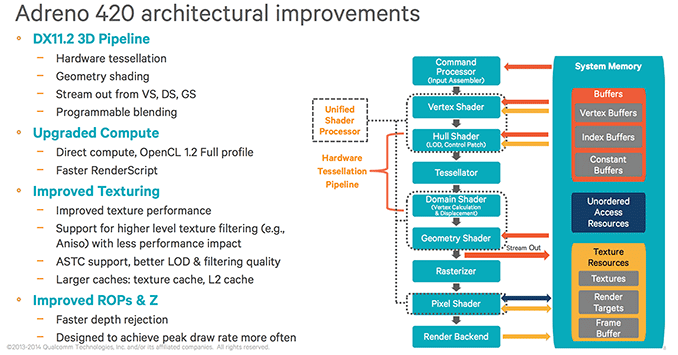
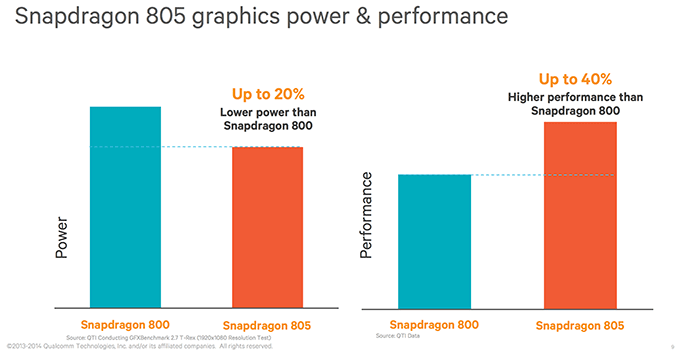
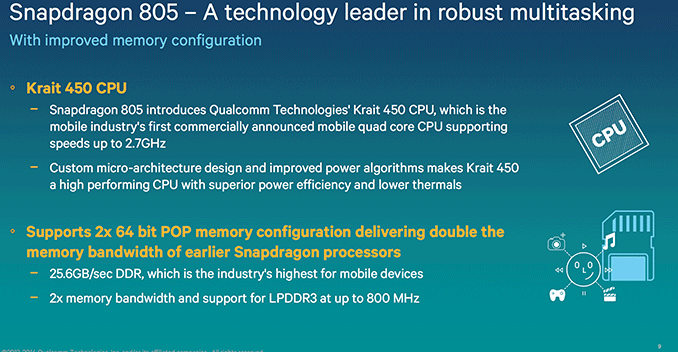
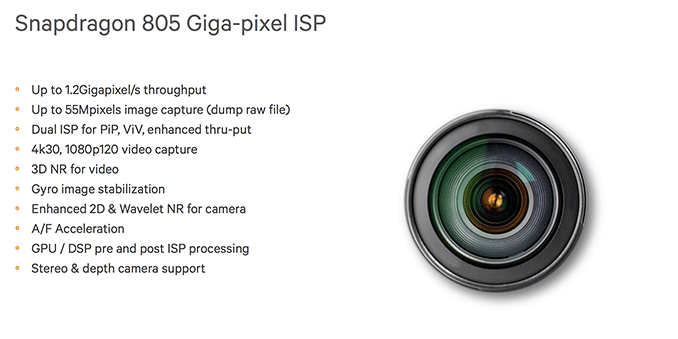
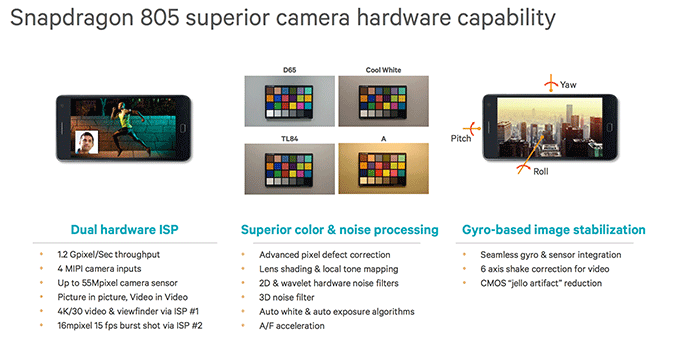

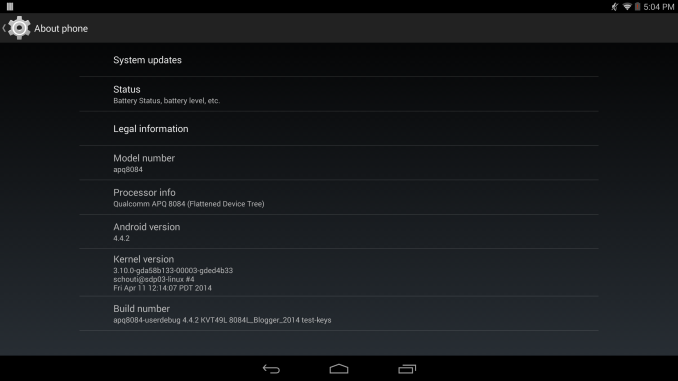








149 Comments
View All Comments
B.Jay - Wednesday, May 21, 2014 - link
Too bad it seems like the LG G3 might not have this beast... So close LG, so close!erikiksaz - Wednesday, May 21, 2014 - link
I wonder what the scrolling performance will be like on the G3 given its resolution and "just" having an 801 chip. I feel like scrolling performance is finally good with the 1080p and the latest generation of processors, but are we going backwards in performance with the leap to 4k?Impulses - Thursday, May 22, 2014 - link
Still dunno why they're pushing for even higher DPI on phones, seems almost absurd at this point.piroroadkill - Thursday, May 22, 2014 - link
Because people are very, very simple in the head and think bigger numbers are better.Frenetic Pony - Thursday, May 22, 2014 - link
"Now assembled by 100% more unpaid Chinese interns!"Vayra - Monday, June 2, 2014 - link
High DPI phones will hopefully die a silent and quick death. Even 1080p is overkill for me on any screen smaller than 5 inch, and staying at 720p at that size is great for battery life...Teo222 - Thursday, June 5, 2014 - link
I don't know man. The difference in pushing and power consumption and price between 720p and 1080p is not that much to deter from the noticeably better quality.Say what you will but I (with my less than perfect vision) can still see pixelation at battery indicators or other small elements. Not to mention native full HD content should you wish it. and obviously SOCs today able to cope with 1080p.
Sabresiberian - Thursday, May 22, 2014 - link
I'm not sure why some people spend as much effort deriding the push for higher pixel densities as they do. Most of it sounds more like sneering for the sake of sneering than having an actual point to make, to me (I'm not saying I know that to be the case here). One should at least make the effort to differentiate himself from the person telling us we should not try to improve the quality of what we see by reaching for more than 60 DPI not all that long ago, because that was "good enough".Human vision isn't the simple mechanism some people think it is. Research has shown a density of over 600 DPI can be useful. I tend to agree that there are other ways to make smart phones better at this point, and it's hard for me to imagine that I would be able to see any benefit beyond 300 DPI personally, but I'm not against increasing the ability of our technology to do more than we can use. Perhaps the technology will lead to improvements in other areas, like responsiveness, or fluidity. Seems to me that giving designing engineers all the power they could possibly use can't be a bad thing. :)
Egg - Friday, May 23, 2014 - link
Increased power draw, cost, performance issues.Frenetic Pony - Saturday, May 24, 2014 - link
Hey looks reasons!